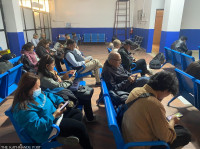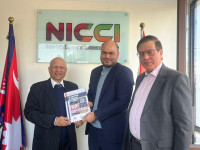Money
Quality of voice services on mobile networks falls short
The call setup success rate varied from 72 to 92 percent, well below the minimum threshold of less than 99.99 percent, the regulator says.
Krishana Prasain
The quality of voice services on the mobile networks of Nepal Telecom, Ncell and Smart Telecom falls short of the standard set by the Nepal Telecommunications Authority when measured for different parameters and in different places of Kathmandu Valley, a report shows.
According to the regulator's Quality Test (Drive Test) of Mobile Service report, the call setup success rate varied from 72 to 92 percent for different mobile service networks across the valley, well below its minimum threshold of less than 99.99 percent
The call setup success rate for Nepal Telecom was 89 percent, for Ncell 92 percent and for Smart Telecom 72 percent, as per the report.
Compared to the authority’s upper limit of 5 seconds for call setup time, Nepal Telecom took 9.32 seconds to set up a call, Ncell 6.24 seconds and Smart Telecom 11.54 seconds, as per the report.
The call block rate of Nepal Telecom was 11 percent, Ncell 8 percent and Smart Telecom 28 percent compared to the maximum of more than 2 percent set by the telecom regulator.
With regard to the call drop rate, it was 4.38 percent for Nepal Telecom, 1.18 for Ncell and 10 percent for Smart Telecom. The maximum is more than 2 percent.
“Inadequate coverage of telcos, poor capacity, poorly managed spectrum and low quality of equipment are the major reasons for the lack of quality in voice services,” Ananda Raj Khanal, former senior director of the authority, told the Post.
"The quality of service has been questionable since 1999 when mobile telecom service was introduced in Nepal," Khanal said. "Firms try to underbid the competition by selecting cheap equipment, due to which the quality of service suffers."
Many people have been experiencing difficulty while making voice calls even in major city areas as it takes many attempts to establish the connection, the voice is garbled due to noise disturbances or it is hard to get a network signal.
Khanal said that it might even be a business strategy of telecom service providers to provide low quality voice service as the bill keeps adding up due to call disturbances.
“We have asked service providers regarding the low quality of service and to maintain the quality of voice services,” said Purushottam Khanal, chairman of the authority.
“We have told the companies to meet the quality requirements and improve their services or we will take action,” Khanal said.
"It might not be possible to achieve a call success rate of 100 percent due to hindrances beyond their control. We will try to find out what is keeping down the call success rate, and ask the service providers to maintain quality,” he said.
Private telecom service providers say that infrastructure plays a major role in providing quality voice service.
“The standard set by the authority is good, but meeting it is not easy. While providing wireless service, it is difficult for service providers to give quality service due to poor infrastructure, insufficient spectrum, location between infrastructure and users, among others,” said an industry insider.
“Regarding quality voice service in Kathmandu Valley, it has become difficult to install towers especially after the earthquake of April 2015. Connections do not succeed for lack of base towers,” said an industry insider.
The government also needs to provide frequency, issue tower erection guideline and provide signal boosting frequency.
The tests were conducted in different parts of Kathmandu Valley from December 31, 2021 to January 11, 2022.
According to authorities, a driving test is a method in which testing tools mounted on a moving vehicle collect key performance indicators of the cellular network by repeatedly making voice or data calls. The networks available at the location were tested simultaneously.
The tools were configured in such a way that a favourable network like 4G, 3G or 2G was selected for each service provider automatically as per availability.
The call test duration was 120 seconds, and calls were made within the network of the service provider.
According to the management information report of the authority, there were 42 million subscribers of voice telephone services as of mid-December last year, among whom 821,875 were fixed subscribers, 41.17 mobile (global system for mobile communication and code division multiple access) subscribers and 2,986 gateway mobile positioning centre subscribers.
Nepal Telecom has 22.78 million users, Ncell 16.84 million, Smart Telecom 2.36 million and other service providers 2,986 users.
Among the total number of voice telephone users, mobile users made up 136.21 percent and fixed telephone users 2.72 percent.




 7.12°C Kathmandu
7.12°C Kathmandu













